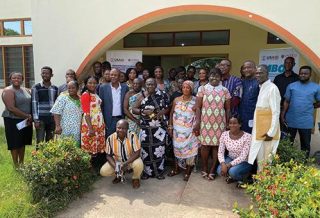FOCUS
Is your school welcoming to neurodiverse students?
By Amanda Morin and Emily Kircher-Morris
Categories: Continuous improvement, Equity, Learning communities, Social & emotional learningOctober 2023
What words would you use to describe the way students feel in your classroom or school? Would students use those same words? And would some students feel differently than others about their experience?
As educators, we work hard to create a culture of care and inclusion in our classrooms and schools. The ideal we strive for is a culture where all students feel safe to take both academic and social risks, one where students feel they can be authentic, they can ask for help, and they’ll be treated with respect and kindness. Schools have made strides in the last decades to create more inclusive environments for students from diverse backgrounds and with diverse needs, and many continue to do this work today.
But we still have work to do, especially to understand and support neurodivergent students, whose brains operate a bit differently from what’s considered “typical” — for example, due to autism, ADHD, or dyslexia. These students frequently must bend their identities to fit within a system that wasn’t created with their needs in mind. They spend a lot of time and energy masking and camouflaging their differences to engage in what we often refer to as “expected” behaviors to experience belonging.
Professional learning about neurodivergence and how to create environments that are supportive has traditionally only been required or provided for special educators. Changing that pattern to ensure all educators have the opportunity to be knowledgeable about the full spectrum of learners in their classrooms is an important step toward achieving equity for all students.
Professional learning about neurodivergence and how to create supportive environments is an important step toward achieving equity for all students. #education #equity #neurodivergence Share on XUnderstanding neurodiversity and neurodivergence
For educators, the word “neurodiversity” might have cropped up in professional learning or perhaps in conversations among colleagues. But it’s more than just a buzzword; it speaks volumes about the vast range of cognitive experiences in our classrooms. The term “neurodivergence” refers to the variation in the human brain regarding socialization preferences, learning, attention, mood, and other mental skills that differ from the societal standards and norms.
Every day, we encounter students whose neurodivergent experiences shape how they communicate, engage, and learn. Sometimes, these differences might be apparent, while at other times, they might quietly influence a student’s daily school life.
By understanding that there is natural variation in human cognition and recognizing students for whom typical teaching and learning structures may not be effective, educators are better equipped to meet students where they are and facilitate learning environments that honor the diverse ways in which all students experience the world.
''Neurodiversity'' is more than just a buzzword; it encompasses the vast range of cognitive experiences in our classrooms & refers to variation in the human brain. Every classroom is neurodiverse. #learning #teaching #equity Share on XConfronting the inclusion paradox
Schools’ efforts to welcome and support students with disabilities have come far in the past few decades. We’ve moved from talking about how to mainstream certain students into “regular” classrooms to talking about how to build inclusive general education classrooms. The change in vocabulary reflects bigger changes in the way we think about inclusion.
Mainstreaming is the practice of placing students with disabilities into general education classrooms for some or all the school day, rather than segregating them into separate special education classrooms. It’s a practice that is grounded in the philosophy that students with disabilities benefit from being around their peers, rather than a philosophy of helping those students learn alongside their peers.
Fortunately, many schools have moved toward the latter philosophy, from talking about and practicing mainstreaming to talking about inclusion and belonging for students with disabilities. Inclusion classrooms are deliberately made up of a balance of students with a wide range of abilities, including students with disabilities and those without.
Research suggests that environments that are inclusive of the spectrum of neurodiversity benefit everyone. We know that neurodivergent students benefit from spending time in classrooms with peers who aren’t neurodivergent. They have lower rates of absenteeism and higher graduation rates than students who spend most of their time in special education classrooms (Hehir et al., 2016). The same research shows that neuro-normative students also gain benefit, not the least of which is being more comfortable with differences.
Inclusive classrooms are a good start to making change, but we’d challenge you to think about inclusion differently. When we talk about inclusion, there’s something key missing from the conversation — the uncomfortable fact that inclusion couldn’t exist without exclusion. True belonging isn’t about being included in spaces you’d otherwise be excluded from. It’s about feeling welcome from the start.
So we encourage you to consider: What would happen if we focused more on belonging by creating classrooms that affirm the identities of and the communication and learning preferences of all the students in the room?
Creating neurodiversity-affirming classrooms
Neurodiversity-affirming spaces honor the whole student by reducing the need for them to mask, encouraging acceptance, and providing ways to reduce struggles that come from differences.
They start from the place of assuming all students belong and embody a culture that honors and accepts differences (Kircher-Morris & Morin, in press). Here are some ways to build that belief system and affirming cultures with your colleagues. These strategies can be woven into many professional learning approaches, including professional learning communities, one-on-one coaching, and collaborative data meetings about students.
Stop fearing labels and call things what they are. Encourage teachers to stop using euphemisms like “quirky” or “thinks a little differently.” Using those phrases sends the message that being neurodivergent is something to be ashamed of and not named.
When we don’t talk to students and each other about the actual labels of things like autism, ADHD, or dyslexia, we miss the opportunity to normalize the fact that there are reasons that a skill is so hard, help students understand that the neurological differences in their brain make it harder to learn the skill, and assure them that we have specific tools that can help and work specifically for brains just like theirs. Coaching is a great way to observe and work with teachers on their use of language that promotes belonging.
Normalize accommodation for all students. The school setting is the perfect opportunity for all students to learn what accommodations work for them, how and where they can access them, and what to expect when they request an accommodation. All students can benefit from having information presented in different modalities, being given more than one way to show what they know, and having the tools available to support them in learning.
For instance, a student having a particularly grouchy day might appreciate an opportunity to work in a quiet environment, a student feeling stressed about family difficulties might find using fidgets calming, and many students might benefit from the availability of speech-to-text when completing a writing task.
Making this shift takes schoolwide and systemwide expectations and effort. Professional learning for leaders can help schools establish guidance and support structures. Professional learning for coaches and other professional learning facilitators can help bring those changes to fruition. And professional learning for teachers can help teachers shift their mindsets and learn how to access or create accommodations for students.
Encourage collaborative team teaching. Integrated collaborative team teaching (also known as co-teaching) has multiple benefits for neurodiverse students. In the best of circumstances, collaborative team teaching pairs general education teachers with special education teachers in a general education classroom.
Team teaching can help teachers get the support they need to educate diverse learners by doubling the number of adults who can work with students to meet specific needs, providing an opportunity for peer modeling and collaboration, and enabling one teacher to sometimes leave the classroom for professional learning, such as observing other classrooms.
Co-teaching can also help educators move away from models in which neurodivergent learners are pulled out of the classroom for specialized support and toward models where one teacher provides targeted support within the classroom. Studies show that when co-teachers who take the time to build trusting relationships with each other and respect and tap into each teacher’s expertise, collaborative team-teaching can successfully meet the diverse learning needs of students (Cook et al., 2017). This is one of most effective ways of providing instruction to support the academic and social-emotional needs of all learners, not just neurodivergent students.
Creating neurodiversity-affirming classrooms requires close collaboration and a shared commitment among school staff. It’s a shift that will not happen overnight and that will not always be smooth — for educators or for neurodivergent students.
Even as we honor neurodiverse ways of thinking, we should also acknowledge students’ and teachers’ challenges. But remembering that neurodiversity-affirming classrooms view both struggles and strengths as valuable allows teachers the space and grace they deserve to shift their mindsets and make gradual change.
Download pdf here.
References
Cook, S.C., McDuffie-Landrum, K.A., Oshita, L., & Cook, B.G. (2017). Co-teaching for students with disabilities: A critical and updated analysis of the empirical literature. In J.M. Kauffman, D.P. Hallahan, & P.C. Pullen, Handbook of special education (pp. 233-248). Routledge.
Hehir, T., Grindal, T., Freeman, B., Lamoreau, R., Borquaye, Y., & Burke, S. (2016). A summary of the evidence on inclusive education. Abt Associates.
Kircher-Morris, E. & Morin, A. (in press). Creating neurodiversity-affirming schools. Free Spirit Publishing.
Categories: Continuous improvement, Equity, Learning communities, Social & emotional learning
Recent Issues
WHERE TECHNOLOGY CAN TAKE US
April 2024
Technology is both a topic and a tool for professional learning. This...
EVALUATING PROFESSIONAL LEARNING
February 2024
How do you know your professional learning is working? This issue digs...
TAKING THE NEXT STEP
December 2023
Professional learning can open up new roles and challenges and help...
REACHING ALL LEARNERS
October 2023
Both special education and general education teachers need support to help...












